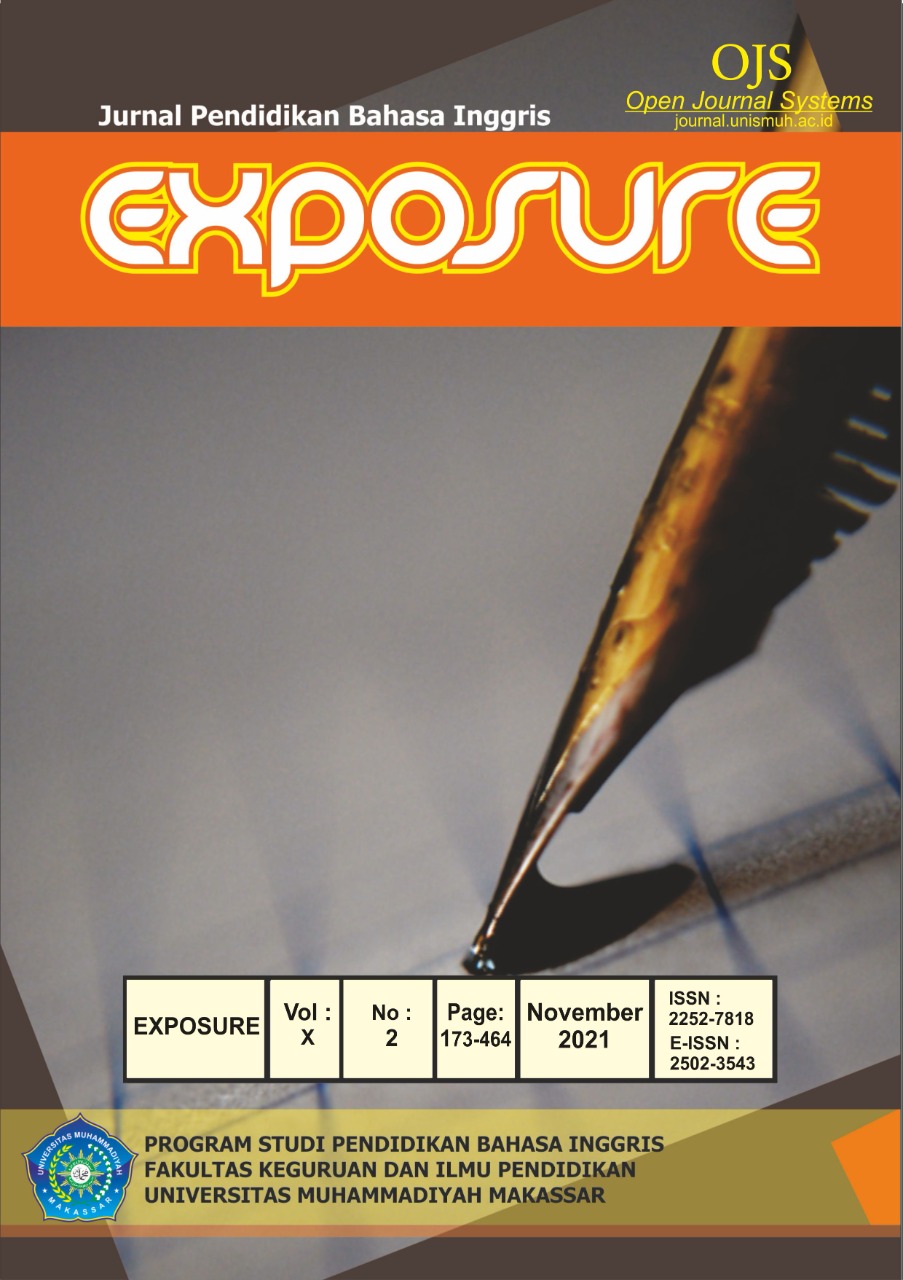ANALYSIS OF TRANSLATION TECHNIQUES IN THE ENGLISH SUBTITLE OF THE MOVIE "KETIKA CINTA BERTASBIH 1"
DOI:
https://doi.org/10.26618/exposure.v10i2.6105Keywords:
translation techniques, cultural differences, source language, target languageAbstract
A mistake in translating a single word may cause thousands of deaths. An unimaginable fact that mistranslation cost 80.000 lives in Japan in August 1945 proves that translating a text should be taken into consideration and done carefully. Translating a source language (SL) into a target language (TL) is problematic and not as simple as only transposing SL into TL because this activity closely relates to different cultures. Therefore, this study is aimed at analyzing the translation techniques in the English subtitle of the movie “Ketika Cinta Bertasbih 1”. This qualitative study focuses on Molina and Albir’s translation techniques used in the English movie subtitle. The primary data were collected from the dialogs and the English subtitle and selected based on the translation problems. Furthermore, the data were analyzed and interpreted descriptively to identify and explain why and how the translation techniques are used in the English subtitle. This study found that five translation techniques were used to translate the dialogs in bahasa Indonesia (SL) into English subtitle (TL). In the subtitle, this study found the use of adaptation (10 times), transposition (9 times), borrowing (7 times), generalization (3 times) and compensation (once). Those techniques were applied to solve problems in translation, such as cultural differences, in equivalence, untranslatability, and grammatical differences. This study concludes that the techniques proposed by Molina and Albir in 2002 have been a great contribution in the field of translation. The cultural problems which lead to in equivalence and untranslatability, as well as grammatical differences are no longer problematic to translators.
References
Catford, J.C. (1978). A Linguistic Theory of Translation: An Essay in Applied Linguistics. Oxford University Press, Oxford.
Creswell, J.W. (2012). Educational Research: Planning, Conducting, and Evaluating Quantitative and Qualitative Research. Pearson Education, Inc., Boston, MA.
Good Translation Might Have Prevented Hiroshima (1989). Retrieved February 9, 2021 from The New York Times: https://www.nytimes.com/1989/08/21/opinion/l-good-translation-might-have-prevented-hiroshima-322089.html
Hatim B. & Munday J. 2004. Translation: An Advanced Resource Book. New York: Routledge Taylor and Francis Group
How to Overcome Untranslatability (2020). Retrieved February 10, 2021 from Language Connect: https://www.languageconnect.net/blog/how-to-overcome-untranslatability/
Jackson A., Guerra N.S. (2011). Cultural Difference. In: Goldstein S., Naglieri J.A. (eds) Encyclopedia of Child Behavior and Development. Springer, Boston, MA.
Ketika Cinta Bertasbih (2013). Retrieved February 1, 2021 from Youtube: https://www.youtube.com/watch?v=nzdPpUO92U0
Molina L. & Albir A.H. 2002. Translation Techniques Revisited: A Dynamic and Functionalist Approach (META Translator’s Journal Vol. 47. No. 2)
Newmark, P. (1988). A Textbook of Translation. Prentice Hall, New York
Nida, E.A. (1964). Towards a Science of Translating, Leiden: E. J. Brill.
Nida, E.A. and Taber, C.R. (1982). The Theory and Practice of Translation, Leiden: E. J. Brill.
Nida, E.A. (2001). Language and culture: Contexts in Translation. Foreign Language Education Press, Shanghai.
Translation Methods of the Translation of Sapardi Djoko Damono’s Poems in English (2016). Retrieved February 10, 2021 from Repositori Institusi Universitas Sumatera Utara: http://repositori.usu.ac.id/handle/123456789/18802
Translation Techniques Analysis of English-Indonesian Manual Book of Smartfren Andromax (2016). Retrieved February 10, 2021 from UNNES Repository: http://lib.unnes.ac.id/26562/
Downloads
Additional Files
Published
Issue
Section
License
Authors who publish with this journal agree to the following terms:
In order to assure the highest standards for published articles, a peer review policy is applied. In pursue of the compliance with academic standards, all parties involved in the publishing process (the authors, the editors and the editorial board and the reviewers) agree to meet the responsibilities stated below in accordance to the Journal publication ethics and malpractice statement.
Duties of Authors:
- The author(s) warrant that the submitted article is an original work, which has not been previously published, and that they have obtained an agreement from any co-author(s) prior to the manuscript’s submission;
- The author(s) should not submit articles describing essentially the same research to more than one journal;
- The authors(s) make certain that the manuscript meets the terms of the Manuscript Submission Guideline regarding appropriate academic citation and that no copyright infringement occurs;
- The authors(s) should inform the editors about any conflict of interests and report any errors they subsequently, discover in their manuscript.
Duties of Editors and the Editorial Board:
- The editors, together with the editorial board, are responsible for deciding upon the publication or rejection of the submitted manuscripts based only on their originality, significance, and relevance to the domains of the journal;
- The editors evaluate the manuscripts compliance with academic criteria, the domains of the journal and the guidelines;
- The editors must at all times respect the confidentiality of any information pertaining to the submitted manuscripts;
- The editors assign the review of each manuscript to two reviewers chosen according to their domains of expertise. The editors must take into account any conflict of interest reported by the authors and the reviewers.
- The editors must ensure that the comments and recommendations of the reviewers are sent to the author(s) in due time and that the manuscripts are returned to the editors, who take the final decision to publish them or not.
Authors are permitted and encouraged to post online a pre-publication manuscript (but not the Publisher’s final formatted PDF version of the Work) in institutional repositories or on their Websites prior to and during the submission process, as it can lead to productive exchanges, as well as earlier and greater citation of published work (see The Effect of Open Access). Any such posting made before acceptance and publication of the Work shall be updated upon publication to include a reference to the Publisher-assigned DOI (Digital Object Identifier) and a link to the online abstract for the final published Work in the Journal.

